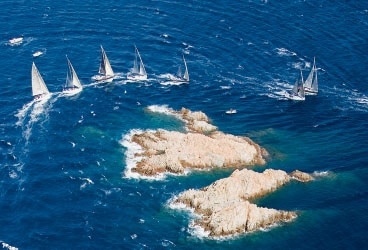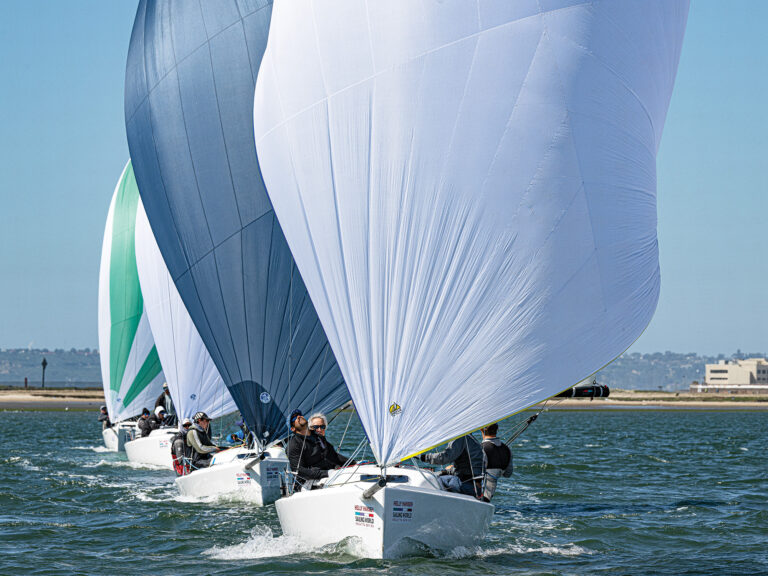
SwanLg
It’s past 6 p.m. by the time we turn downwind for the finish of Race 4 of the Rolex Swan Cup. The sun is closing fast on the rugged mountains west of the Mediterranean harbor of Porto Cervo, turning the water ahead into a sea of diamonds. Only the Swan 45s remain on the racecourse-a dispute about Peroni’s sponsorship of the class delayed our first start until after 3 p.m. The other 70 boats in the regatta are comfortably nestled stern to, crews relaxing by the pool or sharing war stories at the bar. After we cross the finish line a few hundred yards upwind of the harbor entrance, and drop our spinnaker, I take a moment to look back across the impossibly blue water at 20 Swan 45s coming downwind, spinnakers vibrant in the golden light. We slice through the narrow cut and leave the village of Porto Cervo to port. The sun highlights every detail of the luxurious villas set into the rocky Sardinian landscape. Off to starboard sprawl low mansions with immaculate lawns. Hanging off the outside of the port’s quay is a massive superyacht, 200 feet long if it was an inch. Wafting through the mild evening air is the smell of grilled calamari. It makes me hungry and thirsty, but in the most pleasant way. I nod, and say to no one in particular: “OK, I get it. This place is amazing.”Great racing is largely a function of the people and boats. A large, competitive, and classy fleet can make any regatta venue memorable, but the Costa Smeralda, a 24-mile swath of Sardinian coastline purchased by the Aga Kahn and a few partners in the 1960s, is one exception to the rule.For Swans, especially, this venue is the ultimate racetrack. There’s plenty of space for equitable buoy racing, and the labyrinth Maddalena Archipelago for quality distance racing, which is part and parcel of any Swan regatta.And the wind? “It’s like a factory of wind,” says Leonardo Ferragamo, the CEO of Nautor’s Swan, and a longtime member of the host Yacht Club Costa Smeralda. “They build wind here.”The connection between the exclusive Italian resort of Porto Cervo and the Finnish Nautor boatyard goes back to the first Swan Cup in 1980, long before the company came under the control of Ferragamo, well before the fashion house scion ever bought his first Swan in 1986. On the surface it seems an odd pairing-a boatbuilder known for its old-world craftsmanship and timeless style and a resort that caters to Europe’s rich and trendy. But on the water, away from the expensive boutiques and vaguely Moroccan-themed buildings, it makes complete sense. “The place has changed,” says Paul Cayard, a veteran of numerous Porto Cervo events. “But what matters to us, the sailors, has stayed the same.”Northern Sardinia has long been known for its dangerous coastline. In 1855, a French frigate sailing between Corsica and Sardinia wrecked on a reef, killing 750 soldiers bound for the Crimean War. In 1993, an oil tanker crash closed the passage to commercial tankers carrying dangerous cargo. Rather than keep Swan Cup participants away from Sardinia’s most notorious hazards, the event embraces them, using rocky outcroppings as marks and squeezing the fleet through narrow passages, one appropriately named Bomb Alley.A staple of every Swan Cup is a run through the half-mile-wide channel between the Sardinian mainland and Isola Maddalena, a channel strewn with submerged boulders. Many of the rocks are named after the boats that have run up against them, or perhaps the rock-star tactician onboard at the time. Roy Heiner, a Dutch Olympic and Volvo legend, put his name on one in 2004 aboard the Swan 80 Favonius. “We got a bit too excited, too keen to win,” he says. “We knew it was there; it was fairly stupid. If you get really enthusiastic, you think you can pick the boat up over the top of the rocks. But it really doesn’t work like that.”Favonius wasn’t the only boat to run afoul of the underwater obstacles in 2004. Bill Kardash’s first Swan Cup as a skipper began with an unfortunate introduction to Costa Smeralda’s mean streak. “First day, first mark,” he says, “I hit the bricks at Isola dei Monaci.”Kardash, from Annapolis, Md., had sailed in the event in 2000 as a crewmember aboard a friend’s Swan 47. He knew then he had to get Aura, the 1973 Sparkman & Stephens Swan 44 he’d purchased earlier that year, to Porto Cervo.”I was really impressed with the event,” he says. “It’s a fabulous place to sail. And the parties are second to none. Rather than going to an event where Swans are the rarity and you’re competing against much lighter sport boats, you’re racing against boats that are a similar style.”Mechanical problems scuttled Kardash’s plans to ship the boat from Bermuda to Europe after the 2002 Newport Bermuda Race. But he wouldn’t be denied. After the 2004 Bermuda Race, Aura was sent transatlantic for the start of a two-year (and counting) European tour.Aura soldiered through most of the 2004 Swan Cup after its brush with the rocks, though a DNF in the third race cost Kardash any hope of a podium finish. “It was a disappointment,” he says, “so I decided I’d give it one more shot.” In preparation for the 2006 regatta, Kardash made one change based on his experience two years earlier, adding a local Italian sailor he met through the shipwright that did the repair work on his boat. Aura opened the regatta with a pair of seconds, added another in Race 4, missed all the rocks, and finished second in the Classic Division, made up of Swan models no longer in production. The local knowledge was helpful, he says, though there are easier ways to find it. “I strongly encourage people to stay away from the rocks.”Avoiding the land was less of a factor in the Swan 45 class. The biggest one-design class in Swan history, 29 boats, gathered in Porto Cervo, and sailed six of eight races around inflatable marks. Five American Swan 45s made the trip, including Massimo Ferragamo’s Bellicosa and Doug Douglass’ Goombay Smash, which finished first and third, respectively, at the class’s inaugural Gold Cup regatta in Key West in January 2006.At that same event, Dick Weismann’s Vixen struggled to stay out of last place. At the New York YC’s Race Week in July 2006, the final regatta before the boats were shipped to Europe, things went only slightly better, Vixen finishing sixth of seven. Yet Weismann felt his team was turning a corner, and he came to Sardinia with confidence.”We’ve had the boat for two and a half years,” said the 68-year-old money manager early in the regatta. “We’ve had a number of less successful regattas, but we’ve gotten more proficient in the last several. We have a good tactician and mainsheet trimmer and that’s helped us quite a bit. I think we’re more disciplined than we’ve been in the past. I know I am.”The first race in Sardinia went much the way most of the races had gone on the other side of the pond, with Vixen finishing 22nd after being called over early. In the second race, however, Weismann and tactician Bill Hardesty shook off that result and lead the fleet around every mark, easily winning the race. The third went much the same way, another first. A third in the fourth race earned Weismann the Day 2 low-point award in the Swan 45 class. “We’d won trophies before,” he says, “but nothing like this. It’s beautiful.”On the third day of racing, Vixen survived the 75-mile, 9-hour distance race in fifth-all the Swan 45s finished well after sunset-and was in second, 1 point behind Danilo Salsi’s DSK-Comifin. Weismann lost a little ground on the fourth day of racing, but was able to push his lead over third to 15 points with one race remaining.Whether fighting for the silver-Weismann, Alex Roepers on Plenty, and Douglass started the last race in second, third, and fourth, respectively-or hoping simply to go out on a good note, like my team, the final day of the regatta was a Porto Cervo classic. In lieu of olfactory delights and golden light, we got 25 to 30 knots from the northwest. The initial schedule was for the handicap divisions to have their first buoy race of the regatta while the Swan 45s completed a short distance course. The breeze scuttled those plans, and the race committee sent everyone on a 25-mile course.The first leg was an 8-mile beat deep into Golfo delle Saline. A third of the way up the beat the course squeezed through the half-mile channel between the Porto Cervo headlands and Isola delle Bisce. Whether you won or lost in this crucial segment of the race was secondary to the sensory overload of two-dozen 45-foot boats fighting through a nasty bottleneck.The breeze abated west of the channel, but then returned with even more punch as we rounded the mark and headed downwind. With gusts in the high 20s and, occasionally, low 30s, we carved deep furrows in the blue sea. Numerous boats wiped out as they tried to soak low enough to slip past Punta Rossa without jibing. We eventually had to jibe-the hairiest maneuver of the entire regatta-then jibe back and switch to the jib top as we headed up to make the second turning mark. From there it was an 8-mile beam reach, the main flogging most of the time, and then another short reach to the finish. We crossed the line in 15th, about our average for the regatta. Vixen locked up second overall with a ninth. Goombay took fourth in the regatta, Plenty, fifth.Weismann, to no surprise, gushes about the sailing in Sardinia. “You couldn’t have asked for anything more,” he says. “It was just about as good as it gets.”But then again, finishing second in a 29-boat fleet will have that effect. A more unbiased opinion is probably found further down in the pack. Andy Fisher decided to bring his Swan 45 Bandit to Sardinia at the last minute, and finished 12th. “The venue is fantastic,” he says. “It’s majestic. You hear about Porto Cervo and sailing, they’re synonymous with each other.”I couldn’t agree more, though for me, it’ll always be Porto Cervo, sailing, and the scent of grilled calamari.









